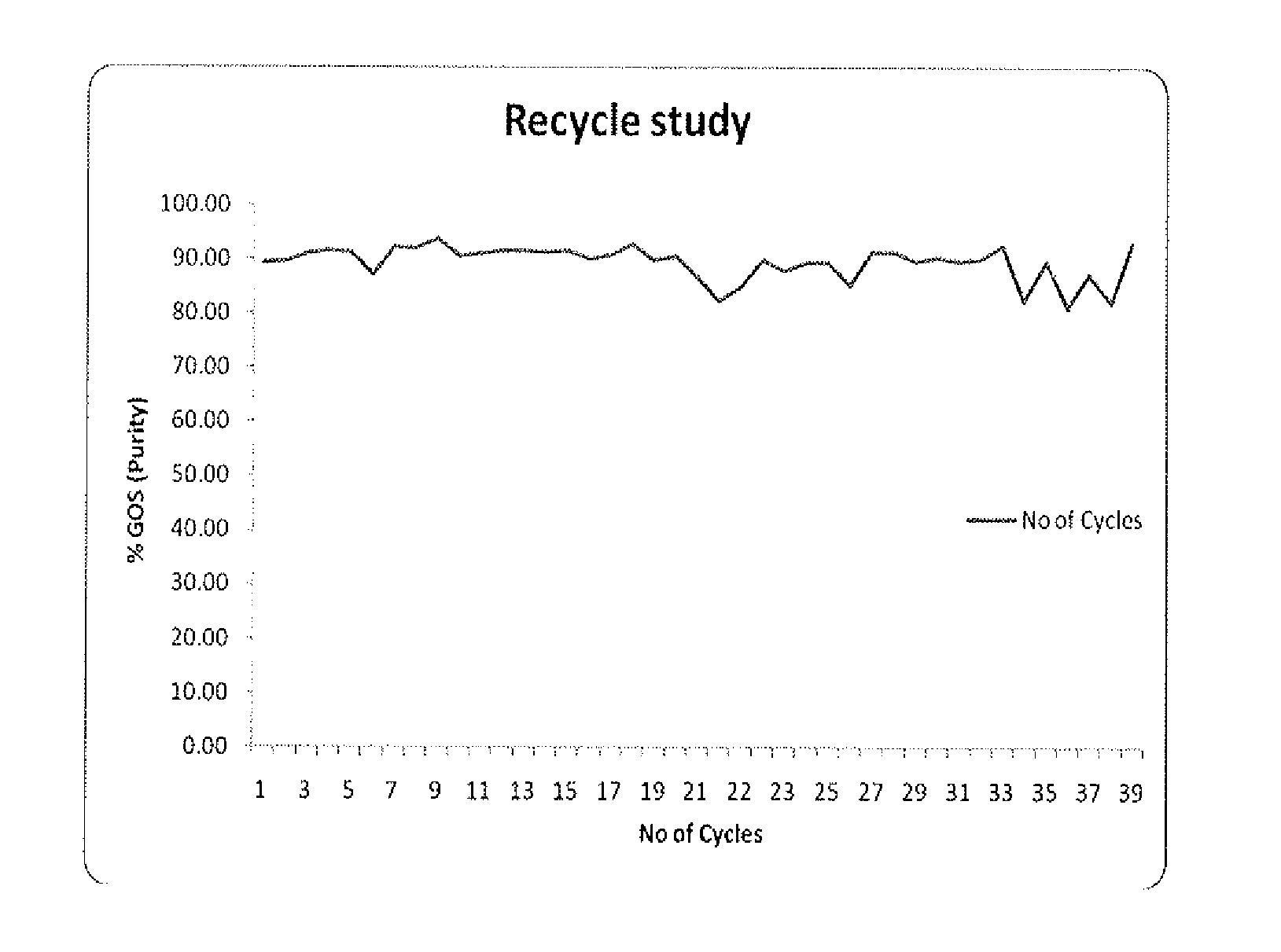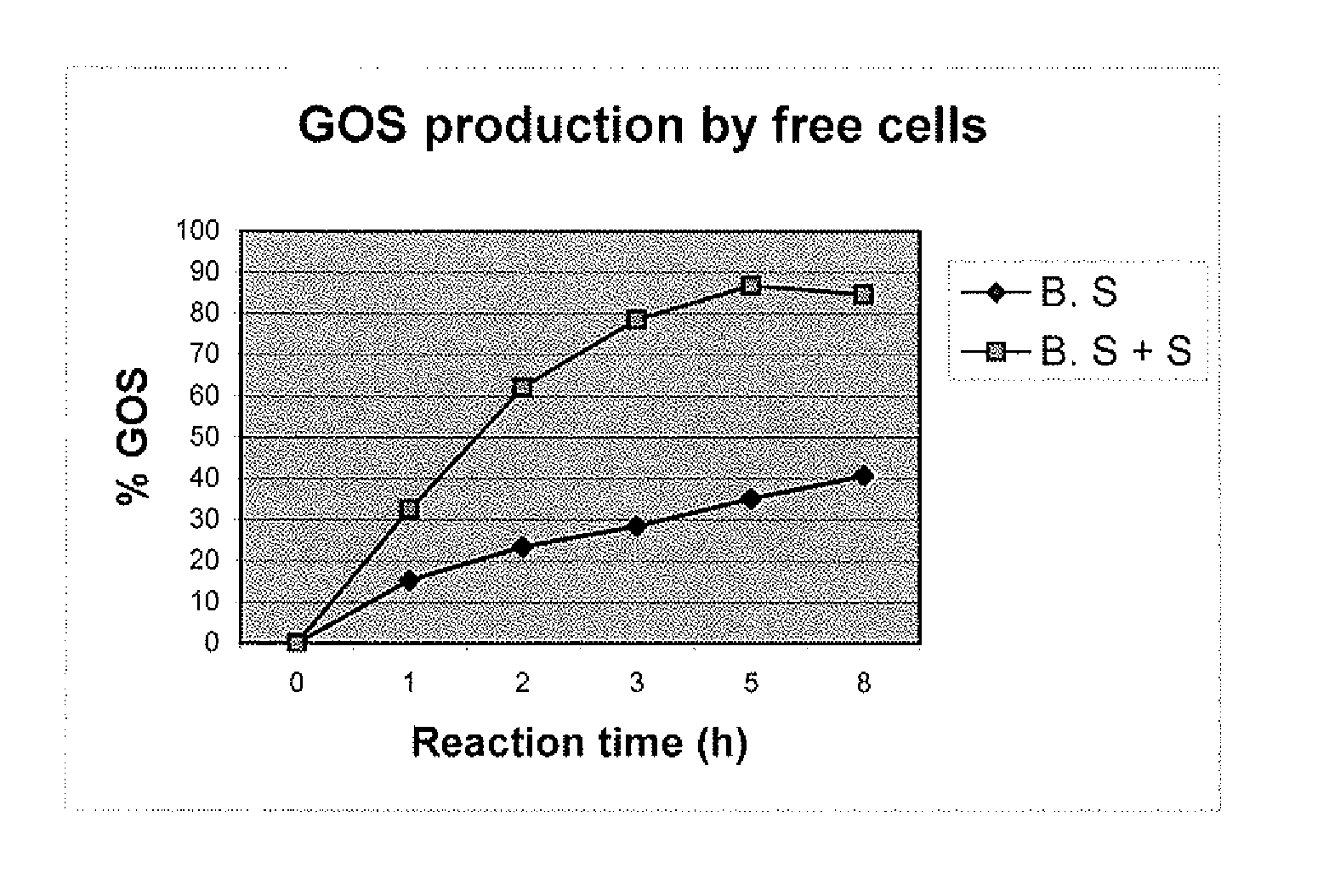Process for production of galactooligosaccharides (GOS)
a technology of galactooligosaccharides and process, applied in the direction of fertilization, etc., can solve the problems of high cost of extraction and purification of enzymes, enzyme denature, and immobilized enzyme use, and achieve the effect of high purity and yield
- Summary
- Abstract
- Description
- Claims
- Application Information
AI Technical Summary
Benefits of technology
Problems solved by technology
Method used
Image
Examples
example 1
Isolation of Lactose Hydrolyzing B. singularis Culture
[0046]B. singularis, TCL-IC / NUT-1, was isolated from dairy effluents by serial dilution method on Yeast-Malt-Peptone (YMP) medium of the following composition; Yeast extract 0.3%, Malt extract 0.3%, Peptone 0.5%, Dextrose 1% and Lactose 1%, and agar 2.0%, pH 6.5.
[0047]Working stock culture: The cultures were streaked on YMP slants and incubated for 48 h at 27° C. These slant cultures were used as working stock culture.
[0048]Preparation of inoculum: 50 ml YMP medium in 250 ml flask was inoculated with a loop full of culture from the slants and incubated in a shaker for 48 h at 27° C. at 180 rpm.
[0049]Shake flask trials: 150 ml of YMP medium in 500 ml flasks was inoculated with 5% inoculum and incubated on the shaker for 48 h at 27° C. at 180 rpm. The samples from the shake flask were taken aseptically and assayed for GUS production as given in Example 2.
[0050]Fermentation trials: 3 l of YMP medium was charged in 5 l fermentor and ...
example 2
Assay for Galactooligosaccharide Production
[0051]25 ml of the cell suspension from the shaker flask or fermentor was centrifuged to obtain cell pellet. The cell pellet was suspended in 15 ml of 40% lactose solution and kept on shaker at 50° C. and 280 rpm agitation. 0.5 ml of the samples was taken out centrifuged to remove the cell biomass. The supernatant was diluted 50 times with milli Q water. 5 μl of diluted samples was injected in to the HPLC system.
[0052]HPLC analysis: The concentration of sugars (glucose, galactose, lactose, and Galactooligosaccharides) was determined by HPLC. The HPLC (Waters 717) system consisted of refractive index detector (waters W2467) and carbohydrate column Phenomenex (RNM 00h-0316, REZEX 300 mm L×7.5 mm, pore size 8 u) ID column. The column temperature was maintained at 80° C. Water was used as mobile solvent with flow rate of 0.5 ml / min. Galactooligosaccharides and other sugars were determined as weight percentage of total sugars based on the area o...
experiment 3
Production of Galactooligosaccharides by Free Cells of B. singularis
[0053]25 ml of cell suspension from the shaker flask or fermentor was centrifuged to obtain cell pellet. The cell pellet was suspended in 15 ml of 30% lactose solution and kept on shaker at 50° C. and 180-rpm agitation.
TABLE 1Galactooligosaccharide production by free cell of B. singularis.Reaction time(h)% GOS116.00325.40635.20
[0054]The results in Table 1 indicate the galactooligosaccharides production is higher than reported by Yang et al., while it is same as reported by Shin et al 199
PUM
 Login to View More
Login to View More Abstract
Description
Claims
Application Information
 Login to View More
Login to View More - R&D
- Intellectual Property
- Life Sciences
- Materials
- Tech Scout
- Unparalleled Data Quality
- Higher Quality Content
- 60% Fewer Hallucinations
Browse by: Latest US Patents, China's latest patents, Technical Efficacy Thesaurus, Application Domain, Technology Topic, Popular Technical Reports.
© 2025 PatSnap. All rights reserved.Legal|Privacy policy|Modern Slavery Act Transparency Statement|Sitemap|About US| Contact US: help@patsnap.com



